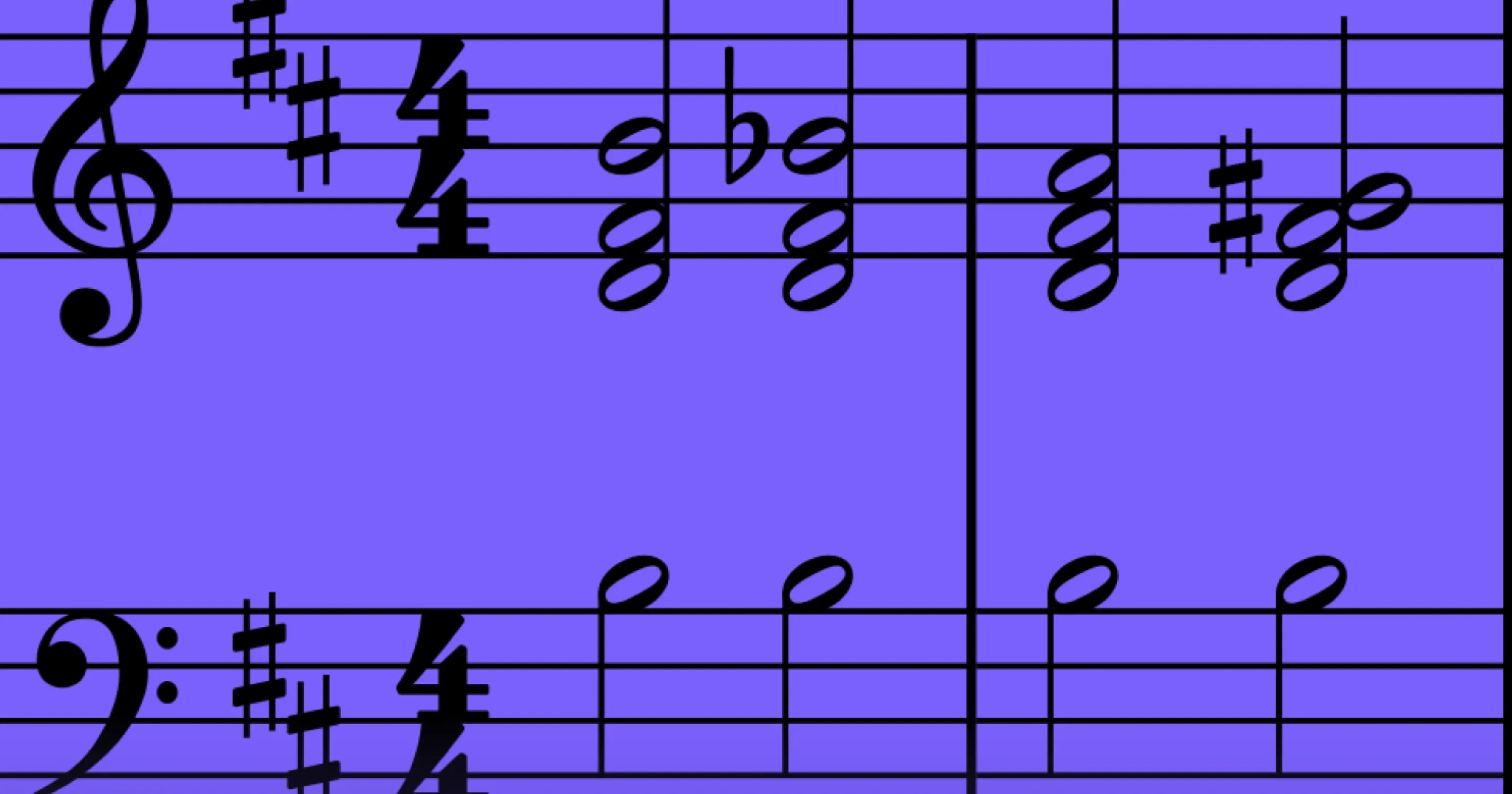
A Comprehensive Guide on Creating Seventh Chords in D Major
Learn to build and use seventh chords in D Major with this in-depth guide. Explore their harmonic functions, famous examples, and practical ways to enhance your music.
Introduction
Seventh chords are essential for adding depth and complexity to music, and they're a great first step beyond basic triads. They're built by adding a seventh note (seven notes above the root) to a triad, creating a richer harmonic texture.
While common in jazz, seventh chords, and other extensions appear in rock, blues, classical, and many contemporary styles, bringing tension, warmth, and emotional nuance.
This article will teach you how to construct all the seventh chords in D Major, explain their harmonic function, and highlight their use in popular songs. By the end, you'll be able to use these chords in your own playing, whether for improvisation, composition, or simply to deepen your musical understanding.
D Major Scale and Chord Construction
The D Major scale consists of the following notes:
- D - Tonic (1st degree) - I
- E - Supertonic (2nd degree) - ii
- F# - Mediant (3rd degree) - iii
- G - Subdominant (4th degree) - IV
- A - Dominant (5th degree) - V
- B - Submediant (6th degree) - vi
- C# - Leading Tone (7th degree) - vii° (diminished chord)

Each note in a key has a corresponding scale degree, which we use to build chords. Chords are constructed by stacking notes in thirds.
Because there are different kinds of seventh chords, understanding how thirds can be altered is key. Chord construction involves these intervals:
- Root: The starting note.
- Third: Can be major or minor.
- Fifth: Can be perfect, diminished (lowered by a half-step), or augmented (raised by a half-step).
- Seventh: Can be major or minor (and even double-flatted, though less common).
Altering any of these intervals by a half-step takes us outside the diatonic notes of the D Major scale.
Adding a seventh to a triad creates a seventh chord. The specific type of seventh chord depends on the combination of the triad type (major, minor, diminished, augmented) and the type of seventh (major, minor).
The 7th chords in D Major are: Dmaj7 - Em7 - F#m7 - Gmaj7 - A7 - Bm7 - C#7b5.
Each type of seventh chord has its own distinct sound and harmonic function. In the following sections, we'll explore the diatonic seventh chords within the key of D Major. Afterward, we'll delve into the specific characteristics of each seventh chord type.
Types of Seventh Chords in D Major
I - D Major 7
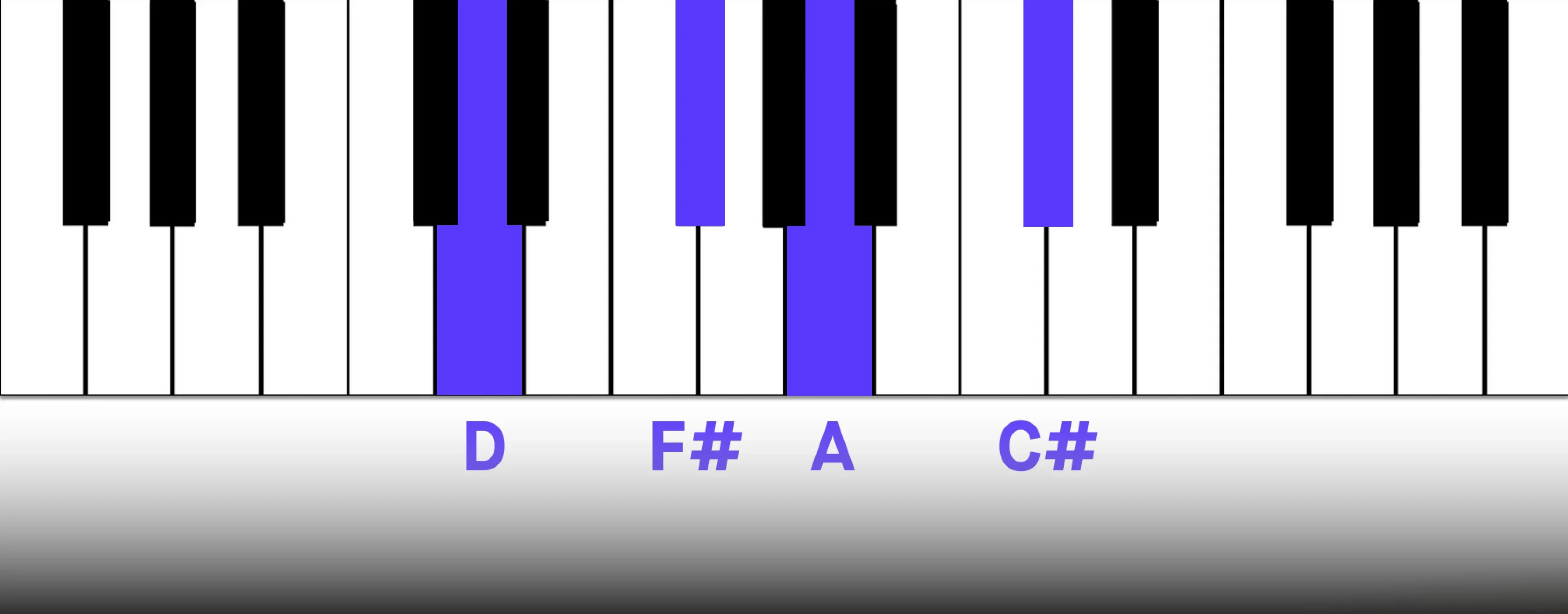
The Dmaj7 chord has a bright, open sound and, as the tonic chord in D Major, creates a feeling of stability, resolution, and groundedness. This tonic stability makes it a natural choice for the beginning and end of musical phrases and progressions, providing a sense of closure. For more on using cadences in D Major to add emotional weight to your musical phrases, see our guide,"A Comprehensive Guide to Crafting Chord Progressions in D Major”.
ii - E Minor 7
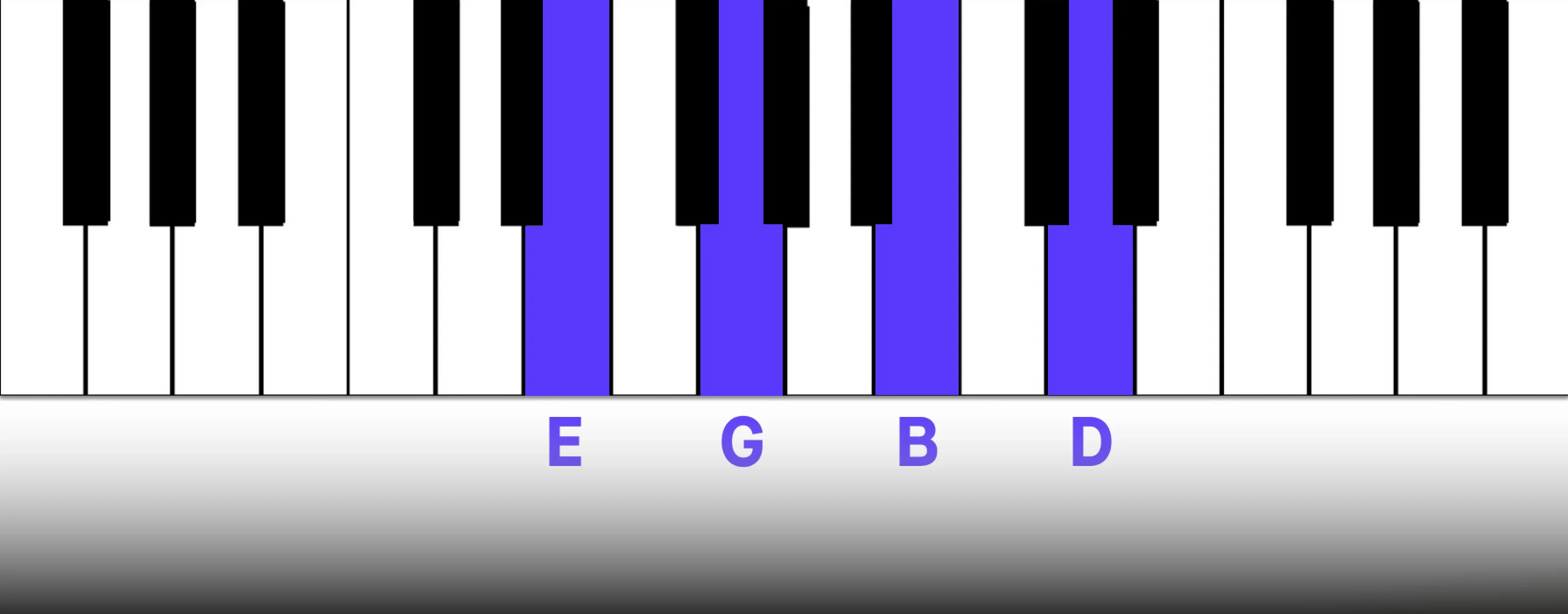
The Em7 (supertonic seventh chord) is important in harmonic progressions, especially as a pre-dominant chord. Its minor quality combined with the added seventh creates tension and forward motion, making it popular in jazz and contemporary music. A prime example is its use in the classic jazz progression ii7 (Em7) - V7 (A7) - I (D), where it smoothly leads to the dominant chord before resolving to the tonic. This progression is a jazz staple, but also frequently appears in pop, rock, and classical music.
iii - F# Minor 7
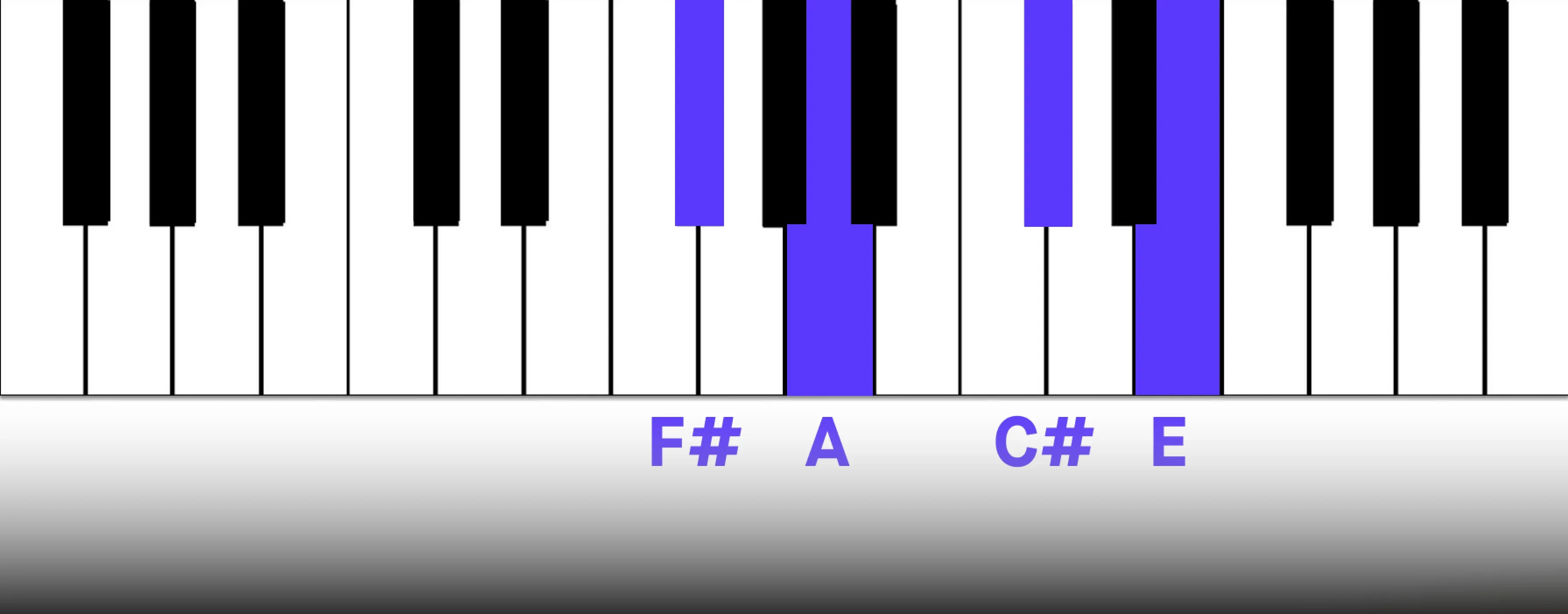
A key function of the F#m7 chord is its ability to substitute for the tonic. Sharing three common tones (F#, A, and C#), it provides a smooth, yet distinct, harmonic variation while maintaining a sense of tonal stability.
This makes it useful when a gentler transition to or from the tonic is desired. It also functions effectively as a passing chord, creating a more fluid connection between other chords in a progression.
IV - G Major 7
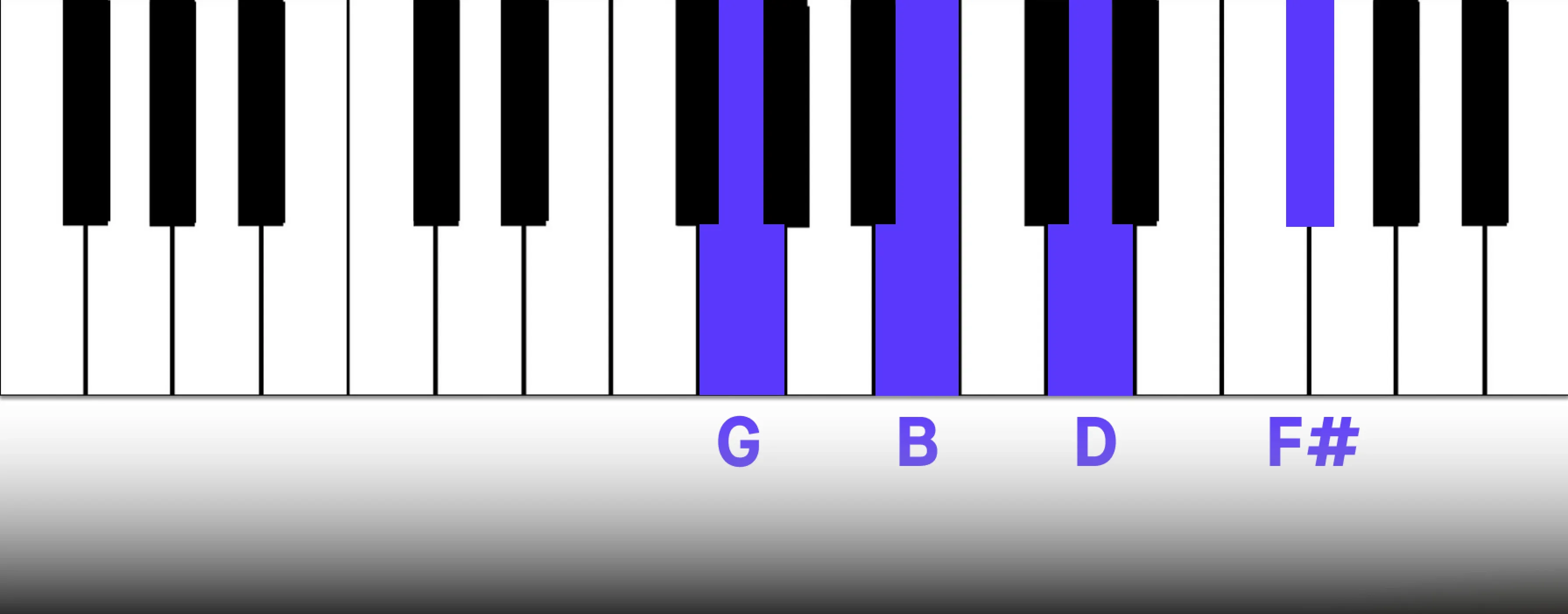
As the subdominant chord in D Major, Gmaj7 adds a smooth, almost dreamy quality to progressions. The subdominant creates a sense of harmonic movement away from the tonic, building anticipation.
It often leads to the dominant, setting up a strong resolution. Another common use is its resolution back down to the tonic, creating a smooth and satisfying conclusion.
V - A Dominant 7 (A7)
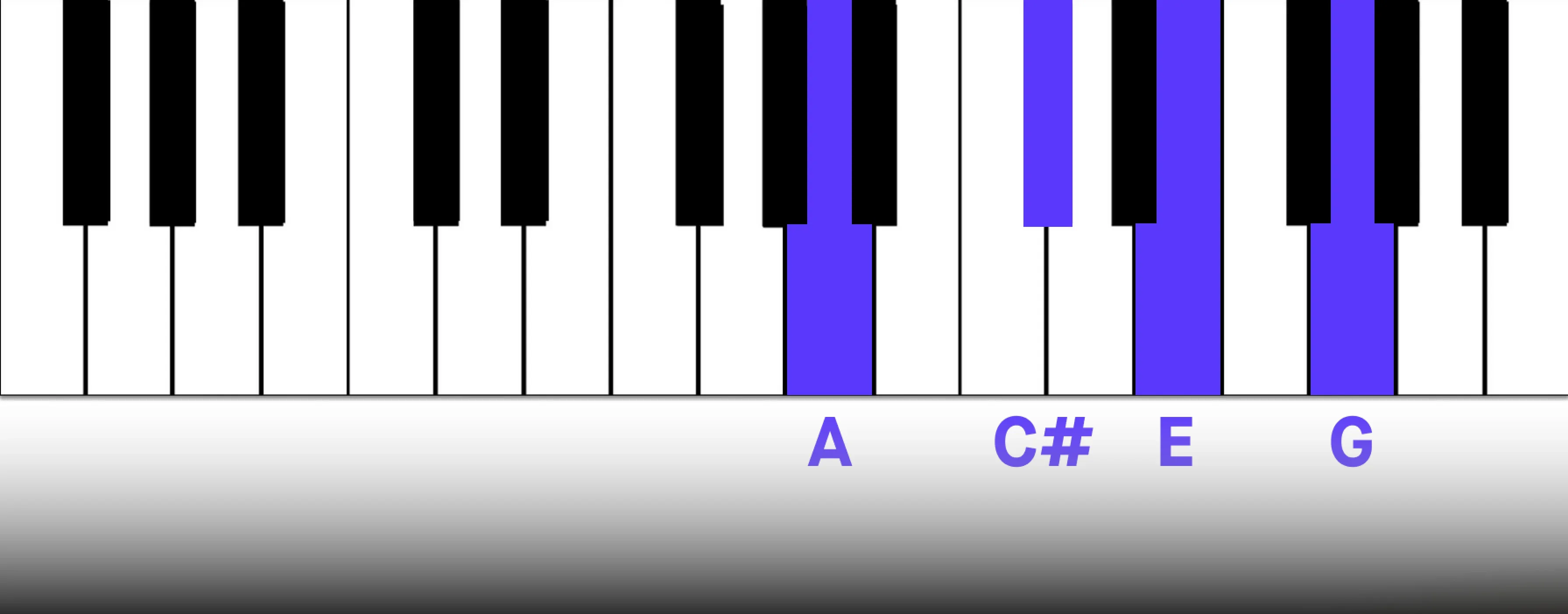
The dominant 7th chord's defining characteristic is its powerful gravitational pull toward the tonic. This comes from the fact that two of its notes are only a half step away from the root and third of the tonic chord, respectively. This close proximity creates a strong, almost magnetic, pull for resolution to the home of the key.
Another reason for this need for resolution is due to the presence of the tritone, a dissonant interval spanning six half-steps. This tritone, formed between the third and seventh of the chord, adds another layer of instability, further intensifying the need for resolution to the stable consonance of the tonic.
The resolution to the tonic from the dominant 7th chord provides a sense of closure and finality, satisfying the harmonic tension built up by the dominant.
vi - B Minor 7
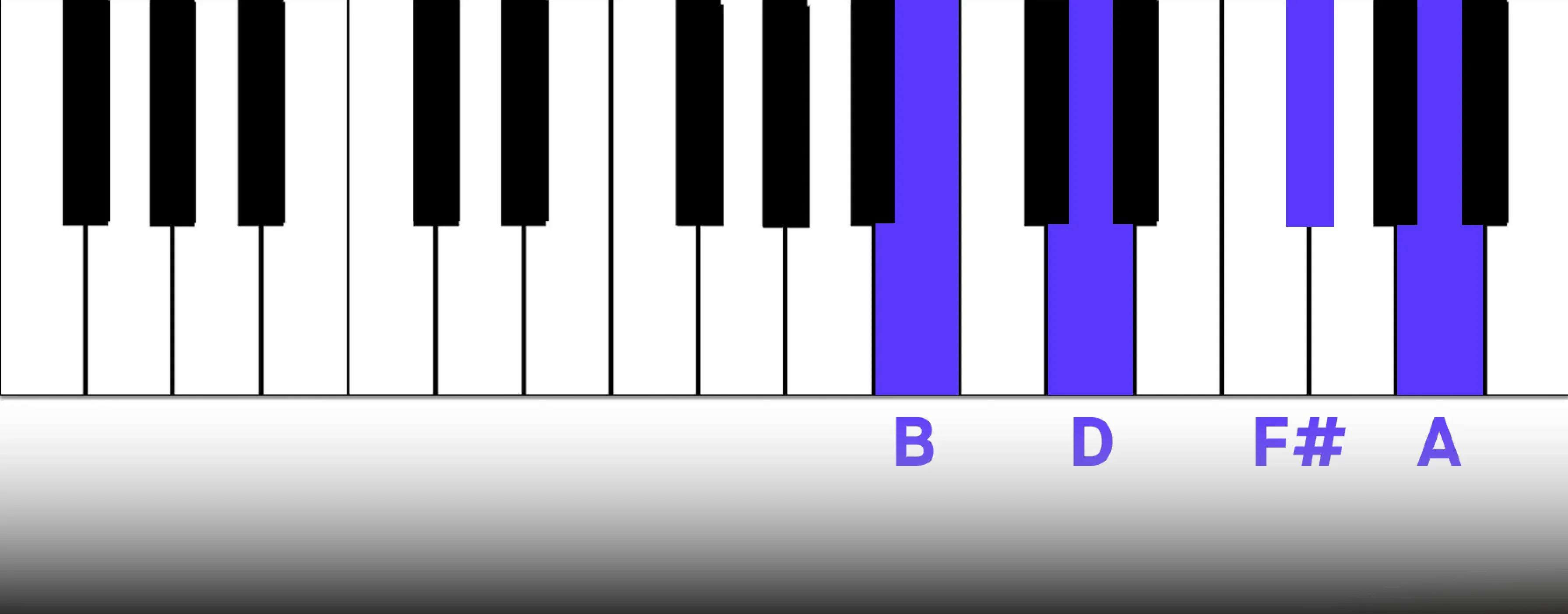
The Bm7 chord possesses an emotional, introspective quality, often evoking feelings of longing, melancholy, or vulnerability. As the submediant, it's frequently used to deepen the emotional impact of a progression, adding harmonic contrast to the major primary chords in D Major.
While the submediant is a minor chord, its minor quality is less pronounced than that of the supertonic. This is because the submediant shares two notes with the tonic chord, creating a stronger connection and reducing its sense of distance from the overall harmonic context. In contrast, the minor supertonic typically introduces more dissonance and tension, creating a more dramatic effect. The submediant's closer relationship with the tonic results in smoother, more familiar transitions, making it feel less foreign to the listener.
vii - C# Half Diminished 7
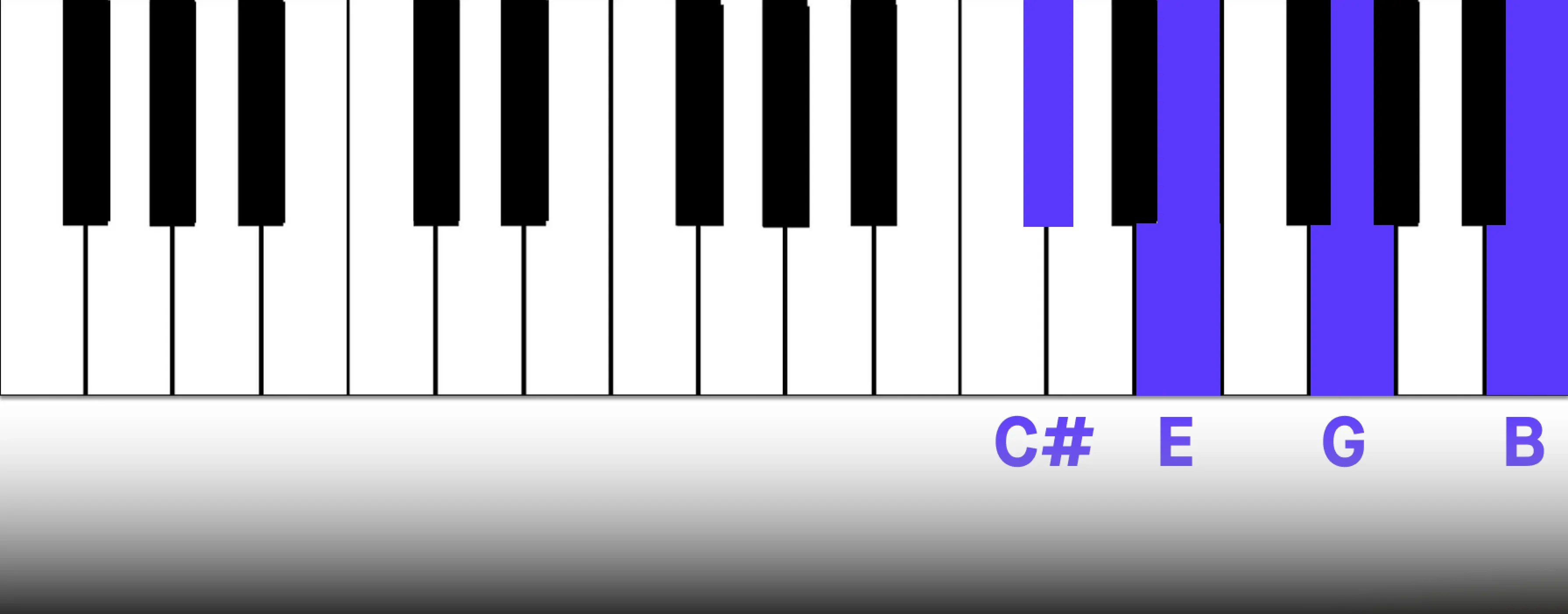
The C#m7b5 chord has a distinctive, tense, and somewhat dark character, which comes from its diminished fifth and minor seventh intervals.
As the leading-tone chord, it creates a powerful pull toward the tonic. Its half-diminished nature introduces instability, tension, and dissonance, which are typically resolved when the chord progresses to a more consonant and stable harmony. Common in jazz, the C#m7b5's darker, jazzy quality adds complexity and emotional depth.
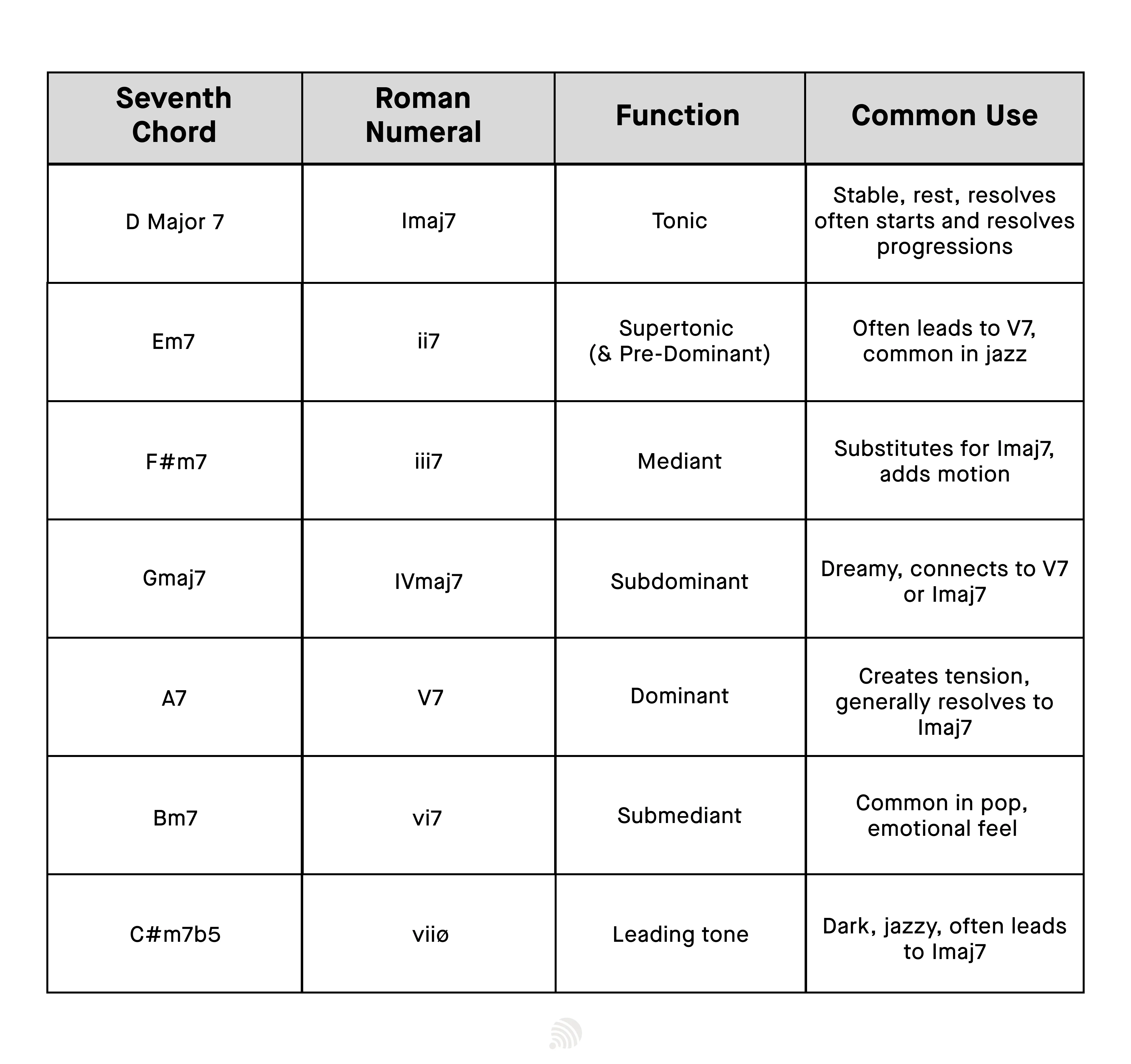
Different Types of Seventh Chords
Major Seventh Chord (Dmaj7)
Formula: Root - Major 3rd - Perfect 5th - Major 7th Notation: Dmaj7, DM7, D△7, D△ Diatonic scale degree: Tonic (I) - Subdominant (IV)
Sound & Function: The major seventh chord, often used as the tonic in major keys, possesses a lush, sophisticated sound. While frequently heard in jazz, pop, and R& B, its use extends across genres.
Structurally, it's built by adding a major triad on top of another major triad, resulting in a chord that feels both stable and somewhat unresolved. This sense of mild unresolvedness is exemplified by Satie's"Gymnopédie No. 1", which famously alternates between Dmaj7 and Gmaj7.
Dominant Seventh Chord (D7)
Formula: Root - Major 3rd - Perfect 5th - Minor 7th Notation: D7 Diatonic scale degree: Dominant (V) Sound & Function: As the principal tension-creating chord, the dominant 7th typically resolves to the tonic, producing a satisfying sense of resolution known as a perfect cadence (V7-I). This V7-I resolution is a cornerstone of Western music, playing a vital role across numerous popular genres. While the diatonic dominant 7th chord occurs naturally only on the fifth scale degree, dominant 7th chords are frequently used in other positions within a scale. For instance, secondary dominants allow for the temporary tonicization of any chord. This is achieved by preceding the target chord with a dominant 7th built a perfect fifth above it. This creates a temporary V7-I relationship in a different key, making the target chord sound like a momentary tonic. For a deeper dive into this topic, see our article "A Comprehensive Guide to Crafting Chord Progressions in D Major".
In blues music, the dominant 7th chord is often heard in positions other than the fifth degree, notably on the tonic and subdominant chords. This usage creates the characteristic bluesy feel and harmonic flavor.
Minor Seventh Chord (m7)
Formula: Root - Minor 3rd - Perfect 5th - Minor 7th
Notation: Dm7, Dmin7, D-7
Diatonic Scale Degree in D Major: Supertonic (ii), Mediant (iii), Submediant (vi)
Sound & Function: The minor seventh chord possesses a warm, smooth, and somewhat melancholic quality. In music theory, it's widely recognized for this characteristic sound, often described as introspective or longing.
This makes it a versatile tool for conveying a range of emotions. One of the most recognizable uses of the minor seventh chord, particularly the ii7, is in the classic jazz standard progression ii7-V7-I. This progression is a cornerstone of jazz, its harmonic effectiveness and versatility making it a staple in countless songs.
The minor seventh chord's smooth, mellow character makes it ideal for creating a sense of gentle sadness or reflection. Its use in the ii7-V7-I progression highlights its ability to create smooth voice leading and harmonic movement.
Beyond jazz, the minor seventh chord also finds frequent use on the sixth scale degree in various genres, especially pop music. Its presence in pop songs often adds a touch of sophistication and emotional depth, enriching the harmonic landscape.
Half-Diminished Seventh Chord (ø7)
Formula: Root - Minor 3rd - Diminished 5th - Minor 7th (becase of the lowered 5th in a diminished chord, the distance between the 5th and 7th is actually 4 half steps, which equals a major 3rd).
Notation: Dø7, Dm7b5
Diatonic Scale Degree in D Major: Leading tone (vii°)
Sound & Function: The half-diminished seventh chord possesses a dark, mysterious sound, frequently employed in jazz, blues, and funk. It adds both depth and richness to chord progressions. Its inherent instability creates a sense of longing for resolution to a more stable harmony.
It's worth noting that the Dm7b5 chord is often referred to by this name rather than as a"half-diminished seventh"or using the ø7 symbol, though all three refer to the same chord.
Diminished Seventh Chord (°7)
Formula: Root - Minor 3rd - Diminished 5th - Diminished 7th
Notation: D°7, Ddim7 Diatonic Scale Degree in D Major: vii° (harmonic minor)
Sound & Function: The diminished seventh chord is characterized by its highly tense and unstable sound, a result of its fully diminished structure. The "seventh" of a diminished 7th chord, located on the sixth scale degree, is created by stacking four consecutive minor thirds. This symmetrical chord construction means that adding another third results in the octave of the root.
Interestingly, the diminished 7th chord can be inverted to create different dominant seventh chords simply by moving a note up or down a semitone.
For example, in the key of D Major, lowering the root of a diminished 7th chord by a half step creates a C7 chord. Similarly, lowering the seventh by a half step produces an A7 chord.
This inherent versatility makes the diminished 7th chord a powerful tool for key modulations, seamlessly transitioning between different tonal centers. It frequently functions as a passing chord, smoothly connecting other chords in a progression.
It also exhibits a strong tendency to resolve to either the tonic or dominant chord, providing a sense of harmonic closure.
A notable example of the diminished 7th chord's use can be heard in Garth Brooks' "Friends in Low Places".
Minor Major Seventh Chords
Formula: Root - Minor 3rd - Perfect 5th - Major 7th
Notation: DmMaj7
Diatonic Scale Degree in D Major: (none)
Sound & Function: The major-minor seventh chord possesses a mysterious and highly chromatic sound. Because it doesn't occur diatonically in either major or minor scales, it's less common in traditional harmony.
However, it does appear in "line clichés", where it's most frequently heard. A line cliché involves a sustained minor chord with one voice (often the highest or lowest) moving chromatically downwards.
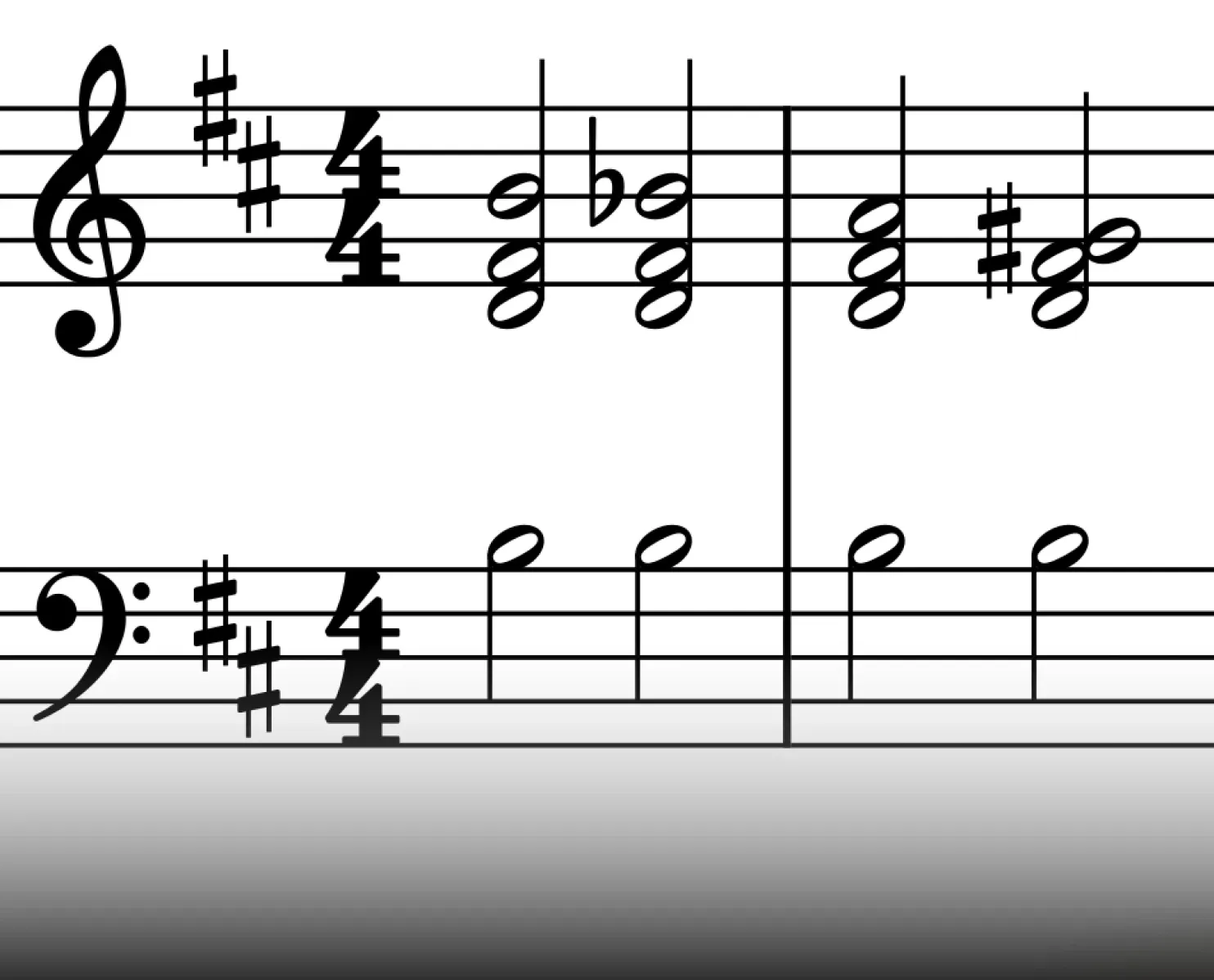
Modified Seventh Chords
The sonic possibilities of seventh chords can be further expanded through alterations. For example, suspended seventh chords and augmented seventh chords offer unique variations on the basic seventh chord structure.
Suspended Seventh Chords
Formula Sus4: Root - Perfect 4th - Perfect 5th - Minor 7th
Formula Sus2: Root - Major 2nd - Perfect 5th - Minor 7th
Notation: Dmaj7sus4. D7sus2
Both seventh and suspended chords possess inherent instability. Combining the seventh with a sus chord further intensifies this quality. These chords are particularly effective as passing chords or for harmonizing ascending or descending bass lines. A notable example can be heard in ABBA's "Happy New Year", where an ii7sus4 chord appears in the progression I - ii7sus4 - I6 - iii - IV.
Augmented Seventh Chord
Formula Sus4: Root - Major 3rd - Augmented 5th - Minor 7th
Notation: Dmaj7#5, Aug+7
This chord is an augmented major chord with an added seventh, often written as Dmaj7♯5 (for example). The notation"augmented seventh"can be ambiguous, as it doesn't clarify whether the 5th or the 7th is altered, making Dmaj7♯5 a clearer and preferred way to represent this chord.
When this chord appears on the fifth scale degree, the augmented fifth acts as a leading tone to the third of the tonic, explaining why the Vmaj7♯5 frequently resolves to the tonic chord.
Chord Progressions using Seventh Chords in D Major
I (D) - vi6 (Bm6) - IVmaj7 (Gmaj7) - I (D) - IVmaj7 (Gmaj7) iv7 (Gm7) - I (D/F#)
The progression effectively uses the diatonic major 7th chord in the subdominant position. The move from Gmaj7 to Gm7 is particularly interesting. The Gm7 (minor iv) is borrowed from the parallel D minor scale - a technique known as using a parallel chord. Billy Joel's "Just the Way You Are" employs this exact progression, enhanced with a few passing chords for added harmonic movement.
IV (G) - ii (Em) - ii7 (Em7) - vi7 (Bm7) - IV (G) - V (A)
The opening chords of ABBA's "Knowing Me, Knowing You" begin with an Em7, followed by the Em triad, creating a sense of intrigue. The subsequent Bm7 further builds anticipation. These two minor chords create a compelling contrast with the brighter, more hopeful IV chord that follows.
Finally, the dominant chord, though without a seventh, provides just enough tension to smoothly transition into the verse. While dominant chords frequently include a seventh for heightened tension, the preceding buildup in this case renders the added seventh unnecessary.
vi7 (Bm7) - ii7 (em7) - iv (gm7) - VII7 (C7) - Imaj7 (Dmaj7)
This is a progression that contains three different types of seventh chords: Major 7th, Minor 7th, and Dominant 7th. It’s easy to spot that the C7 chord is chromatic since we’re in D Major, and the only natural dominant chord always occurs on the fifth scale degree; which in this key signature is A.
Lowering the 7th scale degree from C# to C can be seen as a borrowed chord from D Minor, or that the song temporarily uses the Mixolydian mode.
These chords are found in Jackson 5’s “I Wanna Be Where You Are”.
iii7 (F#m7) - vi7 (Bm7) - I (D/A) - Vsus4 (Asus4) - V (A)
“You Get What You Give” by New Radicals features a high-energy chord progression in the pre-chorus. It starts off with an iii7 chord, followed by another 7th chord on the vi scale degree, adding further harmonic depth.
The use of Vsus4 before the V-chord is a clever way to build anticipation that leads smoothly into the tension of the dominant chord.
Having different sections use different starting chords is a great way to harmonically keep each section unique. In this song, the verse starts on a Dmaj9 chord, the pre-chorus on the iii7, and the chorus on IVmaj9.
V (A) - vi (Bm) - II7 (E7) - IV (G) - V7 (A7)
This chord progression uses two different dominant chords and is heard in Beatle’s “Eight Days A Week”. The final A7 that completes the progression is the diatonic dominant chord. The E7 is chromatic.
The chromatic E7 is often used in the D Major key because it’s used as a secondary dominant (V/V to be exact). However, in this instance, it's important to note that E7 doesn't resolve to A7, and doesn’t result in the V-I interval - which is the purpose of a secondary dominant.
Instead, we can interpret this as a modulation to Lydian mode, a major scale distinguished by a raised fourth scale degree.
I (D) -V7 (A7) - IV
Not every song or section needs a complex chord progression. Even just the primary chords of a key can effectively create movement, tension, and resolution. Adding a seventh to the dominant chord enhances this tension, making the return to the tonic feel even more satisfying.
“Bad Moon Rising” by Creedence Clearwater Revival is a classic song that only uses these three chords.
Imaj7 (Dmaj7) - vi (Bm)- IV (Gsus2) - vi (Bmsus2)
The verse of “Everlong” by Foo Fighters begins with a Dmaj7 chord, creating an unresolved sensation. This instability works well with the sus2 chords that follow, resulting in a progression that feels open-ended and rather ambiguous. The lack of strong resolution keeps the listener engaged, adding to the song’s emotional pull. This is likely a conscious decision.
When the pre-chorus and chorus arrive with complete chords containing major and minor thirds, the contrast becomes even more powerful. The introduction of fuller, more grounded chords heightens their impact, making them feel even more dynamic.
I (D) - I (D7/C) - IVmaj7 (Gmaj7/B) - I (D)
Led Zeppelin uses just two chords and turns them into an interesting progression in their song “Thank You”. The song opens with a three-note chromatic line, moving through a D7 chord on the tonic and a Gmaj7 on the IV scale degree.
This unexpected dominant seventh on the tonic degree introduces a subtle tension, making the progression feel richer and more dynamic.
The shift to Gmaj7 that follows adds warmth and depth.
IV (G) - I (D/F#) - ii7 (Em7) - V11 (G11)
These are the chords from Daft Punk’s “One More Time”. Starting on the IV chord immediately injects energy into the progression, even with simple sustained chords. The following tonic in the first inversion offers a sense of resolution, though it remains harmonically open, avoiding full closure.
The inclusion of Em7 and V11 further enhances the song’s dreamy, spacey quality, which blends perfectly with the sounds and instrumentation of the song which contributes to the song’s ethereal vibe.
I (D) - V (A) - vi7 (Bm7) - IV (Gadd9)
“When Can I See You Again” by Owl City follows this exact chord progression. Throughout the verse, the progression repeats several times, but with a subtle variation. The Bm7 is replaced by Em7 at each turnaround. This small change prevents the progression from feeling overly repetitive.
It’s a clever technique for keeping recurring chords fresh, adding variety without disrupting the overall flow of the song.
IV (G) - V (A) - vi7 (Bm7)
In the pre-chorus to Coldplay’s “Speed of Sound”, we hear a Bm7 chord which adds harmonic depth and interest to the music. Here’s another example of avoiding the tonic of the key in order to heighten its impact as it closes off the chorus of the song.
The Bm7 chord in the pre-chorus of Coldplay's"Speed of Sound"adds harmonic depth and interest. Additionally, the chord progression lacks a tonic. Omitting the tonic in sections like the pre-chorus or bridge creates instability. If the chorus or following section contains the tonic, it will feel more grounded and impactful.
How to Practice Seventh Chords
To familiarize yourself with seventh chords, begin by playing each chord in root position, then explore different inversions. Actively listen to the resulting sounds and identify the intervals creating tension. This understanding will empower you to use inversions creatively, not just for tension and resolution, but also for smooth voice leading.
Here's a simple practice routine:
- Play each seventh chord of the D Major scale in root position to develop comfort with four-note chords.
- Practice smooth transitions between chords, minimizing hand movement.
- Use arpeggios to internalize the sound of each seventh chord. This is a common technique in songs where larger chords are broken down and played in a picking style, often as a lead instrument.
Here are some exercises to develop smooth chord transitions:
- Basic progression exercise: Practice common progressions like Dmaj7 - Gmaj7 - A7 - Dmaj7, focusing on seamless transitions between each chord.
- Two-chord transitions: Practice moving between any two seventh chords (or triads) within the D Major scale. This builds muscle memory and helps you recognize the sound of specific intervals created during the transitions.
- Inversion exercise: Play all the diatonic seventh chords in their 1st, 2nd, and 3rd inversions to become comfortable with their various voicings.
- Transition practice: Work on smooth transitions between inverted and root position chords to develop fluidity and flexibility in your chord changes.
Consistent practice of these techniques will solidify your command of seventh chords in D Major, enriching your harmonic vocabulary and improving your improvisational skills.
Musiversal: For Musicians, by Musicians
Elevate your music by recording your songs with top-tier professional musicians. With Musiversal, you have instant access to over 90+ skilled artists and engineers, ready at the click of a button. Our Unlimited subscription lets you enjoy as many recording sessions as you need with world-class talent.
Find the perfect musician or instrument to bring your musical vision to life. Join your sessions live via a link, collaborate in real-time, and ensure your music sounds exactly as you imagine.
Musiversal offers a wide range of instruments, including drummers, cellists, guitarists, string players, pianists, wind players, bassists, beat makers, vocalists, and much more. Simply schedule a session at a time that suits you and enjoy the process.
If you have a song idea but aren't sure how to develop or finish it, our songwriting sessions can be invaluable. Our experienced songwriters will write lyrics, chords, and harmonies, transforming your initial seed of an idea into a complete piece of music - or they can refine an existing piece of yours and truly make it shine.
Whether you need help with structure, and melody, or want a songwriting collaborator, they’re available at every step of the songwriting process.
Already have finished tracks? Book a mixing and mastering session with a professional engineer to ensure your music sounds polished and ready for release.
Enjoy the Musiversal blog for expert insights on music theory, songwriting, production, gear, marketing, and distribution. We update it weekly.
Your Music, No Limits.
Join the Waitlist